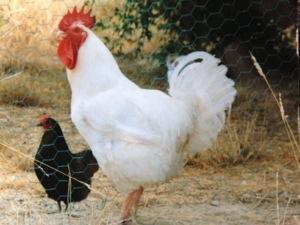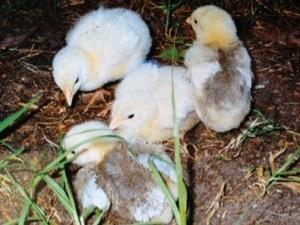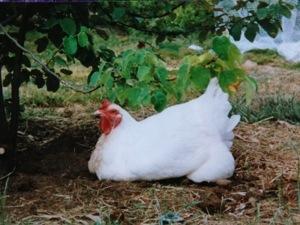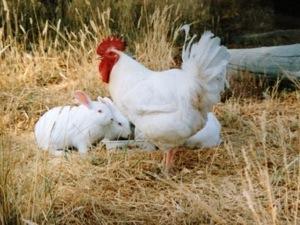 I have a Bachelor of Social Work, and have spent most of my career working in the field of family violence.” Check out Ally on: Made of Stars, Twitter, and Pintrest. Welcome Ally!
H is for…Hatching project.This is Sarge:
I have a Bachelor of Social Work, and have spent most of my career working in the field of family violence.” Check out Ally on: Made of Stars, Twitter, and Pintrest. Welcome Ally!
H is for…Hatching project.This is Sarge:

- Sarge the rooster.
Photo used with kind permission of B. Carmody.
Here is Sarge as a chick, with his sister and brothers:

- Chicks dust-bathing.
Photo by author.
I first encountered Sarge when he lived in an egg. His egg, his world, was part of a school hatching program.
The fragile inhabitants of those 12 eggs emerged into an incubator, to a motherless existence. They did not experience the welcoming chirps or body warmth of a nurturing mother. A heat lamp set to 37 degrees Celsius was their only warmth and comfort.
What is a hatching project?
Hatching projects are promoted as ’fun and easy do-it-yourself programs that enable children to see chicks actually hatching from their eggs’. School teachers are encouraged to use hatching projects in their classrooms.
One company, Living Eggs , asserts that their program provides children with ‘the opportunity to experience the miracle of life first hand…’. Hatching projects are promoted as ‘hands-on’ enhancements for life cycle studies.
When participating in the Living Eggs hatching program, schools are provided with an incubator, eggs, a brooder box for the chicks, educational resources and chick feed.
The company aims for the chicks to hatch on a Wednesday (‘please inform us Wednesday afternoon if there are no signs of hatching’), and instructs that all chicks should be moved to the brooder box by Friday afternoon. It is requested that a ‘responsible person’ take the chicks home over the weekend.
On Monday, the chicks are ‘ready’ to be handled by the students. On the twelfth day, at the completion of the program, the chicks are collected, along with the incubator and brooder box.
What do hatching projects teach children?
According to the companies that provide this ‘experience’ for pre-schools and schools, children are learning about ‘the life cycle’.
A testimonial on the Living Eggs home page states:
‘A wonderful stimulus for work across the curriculum. It gave the children an amazing experience of a real life-cycle’.
Perhaps the chicks were a ‘wonderful stimulus’, however, I do not agree that there is anything ‘real’ about this set-up. A hatching project is not indicative of a ‘real’ life cycle. It is totally artificial!
Another testimonial exclaims:
‘Brilliant! One of the most unique bonding experiences ever.’
Huh!? Who bonded? The kids? The kids and teacher? Or the kids and chicks? Perhaps the teacher and the chicks bonded?
It is disappointing that there is no concern for hen-chick bonding – the bond between mother and baby. I am curious to know what the children are told about the ‘absent’ mother.
In fact, one of the criticisms directed at hatching projects is that the chicks may ‘imprint’ (bond) with the children who are caring for them, only to experience separation anxiety when they are removed from the school a few days later.
Opponents of hatching projects assert that children are being taught to regard the fragile chicks as mere ‘teaching aides’, not sentient beings. This is further enforced when the chicks are collected at the end of the project. The chicks are disposable.
A classroom environment can not emulate the role of a mother hen, who rotates her eggs up to 30 times a day to ensure proper embryonic development. A mother hen communicates with her offspring while they are still inside the eggs, welcoming them and guiding them as they emerge from their eggs.
This particular ‘educational experience’ patronises children. We only give them part of the story. Yes, the avian egg is fascinating. However, the ‘life cycle’ that is demonstrated to school students is a false one. A mother, a hen, is essential for the life cycle. She is the layer of eggs, the one who gave them life.
Not just Chicks
I was dismayed to discover that one company, Hatch n Grow , provides duckling eggs as part of its hatching program.
The Hatch n Grow website provides the following cautionary announcement:
‘PLEASE NOTE: Ducklings can drown if you don’t provide a step for them to get out of the water by themselves. It’s always best to supervise the ducklings in the water and if at any time they look tired or cold put them back near their heat light for a rest.’
It is very unlikely that a duckling would drown under the guidance and supervision of her mother, but in a busy classroom a tired or struggling duckling may go unnoticed.
The web site also states that their program is:
‘Great for keeping the kids in the neighbourhood occupied at home during the school holidays.’
Is that the value we truly wish to place on living beings? When we use living beings as ‘occupiers’ of our children’s time, we treat them as a novelty. The ducklings are reduced to the status of a play thing, a toy.
Ducklings are very cute, undeniably so. I am sure that my kids would love to hold one. But, this is where our influence and guidance as parents is so important. It is essential that we instill in our children a belief that ducklings (and other beings) are not play things, that they have inherent value as living beings.
At all stages, we must ask: Is this action beneficial to the duckling (or chick)? Is it kind, is it right? This process requires empathy.
We must also ask: What are my children learning from this experience? Are these the types of beliefs that I want them to develop about animals?
I do not want my children to regard animals as toys. This belief, therefore, influences the type of activities that I would seek for my children to be involved in. Hatching projects in the home are definitely out.
Sarge’s Story
I rescued four of the chicks from the school hatching project that Sarge was a part of, and took them home to my suburban backyard.
My sister and I named the chicks according to their unique features: Sarge appeared to be ‘the boss’, the benevolent leader. Tails grew her white tail feathers first. Lionel’s tail feathers appeared as distinct ‘lines’. Baby was the smallest.
They were tiny, precious and fragile- and we fell in love with them.
As they grew, two things became apparent-
1. Three were roosters, Tails was the only hen;
2. They were ‘broilers’ (meat chickens), not ‘egg laying’ chickens. The company had stated that the remaining chicks, Sarge’s siblings, were going to a ‘free range’ egg facility. I had not believed this assertion at the time and, as our chicks ‘grew’ into broilers, we confirmed the claims to be false.
Broiler Chickens
As the chicks grew, deformities began to emerge. And grow they did. Rapidly. Broiler chickens have been bred to gain weight fast. They are commonly slaughtered at approximately 30-35 days old (but no later than 55-60 days old). They are just babies.
I felt so relieved that I had brought the chicks to my home. What fate had awaited them otherwise?
Before long, the chickens could barely carry their own weight. Any amount of exertion would render them exhausted. At times it seemed conceivable that their fragile legs may snap under the weight of their unnaturally large bodies. Eventually, Lionel could only walk short distances at a time.
At the time that we shared our lives with Sarge, Lionel, Tails and Baby I had not eaten chicken for 4 years. I had read about broiler chickens and their crippling deformities. I had seen photos of them.
Now, I was sharing my life and home with broiler chickens. I observed their dust bathing and their exploration of the backyard. My heart ached as I watched them struggle to walk.
I wanted everyone to meet them. To know them. To know what these beings endure in order for humans to eat roast chicken and chicken nuggets. They were just babies. Do people realize that they are eating babies?
There was a happier ending for Sarge, Tails, Lionel and Baby.
A New Home
Once Sarge, Lionel and Baby began crowing each morning, it became apparent that it was time to find them a more suitable, more rural home.
That is when Bede Carmody came in to our lives. Bede was living on a property that was home to ex-battery hens. He agreed to provide a home for our 4 friends. For this act of kindness and compassion, I will be grateful to Bede, forever.

- Tails, resting at her new home.
Photo used with kind permission of B. Carmody.
Bede updated us on the lives of our broiler friends with photos and letters, and it became apparent to me that he had welcomed them into his heart.
Sadly, all of these precious chickens died before their first birthday.
Unlike millions of their kin, however, they died FREE. They were not slaves, they were not subjected to the stress of transportation or the horrors of a slaughterhouse – and they knew kindness. In a chicken production facility, they would have been slaughtered before they reached 2 months old.
A Poultry Place
Bede Carmody now runs a no-kill sanctuary called A Poultry Place in Southern New South Wales. A Poultry Place (APP) is home to rescued and unwanted hens, roosters, ducks, turkeys and geese. No doubt, some of the roosters in residence are former hatching project chicks. APP celebrated its 12th birthday this week.
I have not seen Bede for many years, but I look forward to the day that I can hug him and thank him again for his kindness.
I eagerly anticipate the day that Mat and I visit A Poultry Place with our children.
For this is the appropriate place to gain a ‘hands on’ educational experience about chickens and ducks (and others). I want my children to learn about the lives of the precious beings who reside there, to understand that the residents have been blessed with a second chance. I want them to hear about the personalities, habits and ‘quirks’ of Bede’s feathered friends.
My kids can also gain some ‘education’ by helping Bede with some of the never-ending jobs that stack up at an animal sanctuary! I’m thinking cleaning, shoveling, feeding…..that is very ‘hands on’!

- Sarge and his pals at dinner time.
Photo used with kind permission of B. Carmody.
Have you visited an animal sanctuary? Please let me know in the comments.
An alternative to chicken hatching programs, a lesson plan called Beak, Wings and Feet is available here.
More information about A Poultry Place is available here.
References:
Edgar’s Mission
World of Animal Welfare (WOAW)
In My A-Z of Veganism series, I discuss and explore a topic or issue related to veganism, and my experiences as a vegan – as I work my way through the alphabet!
Ally
